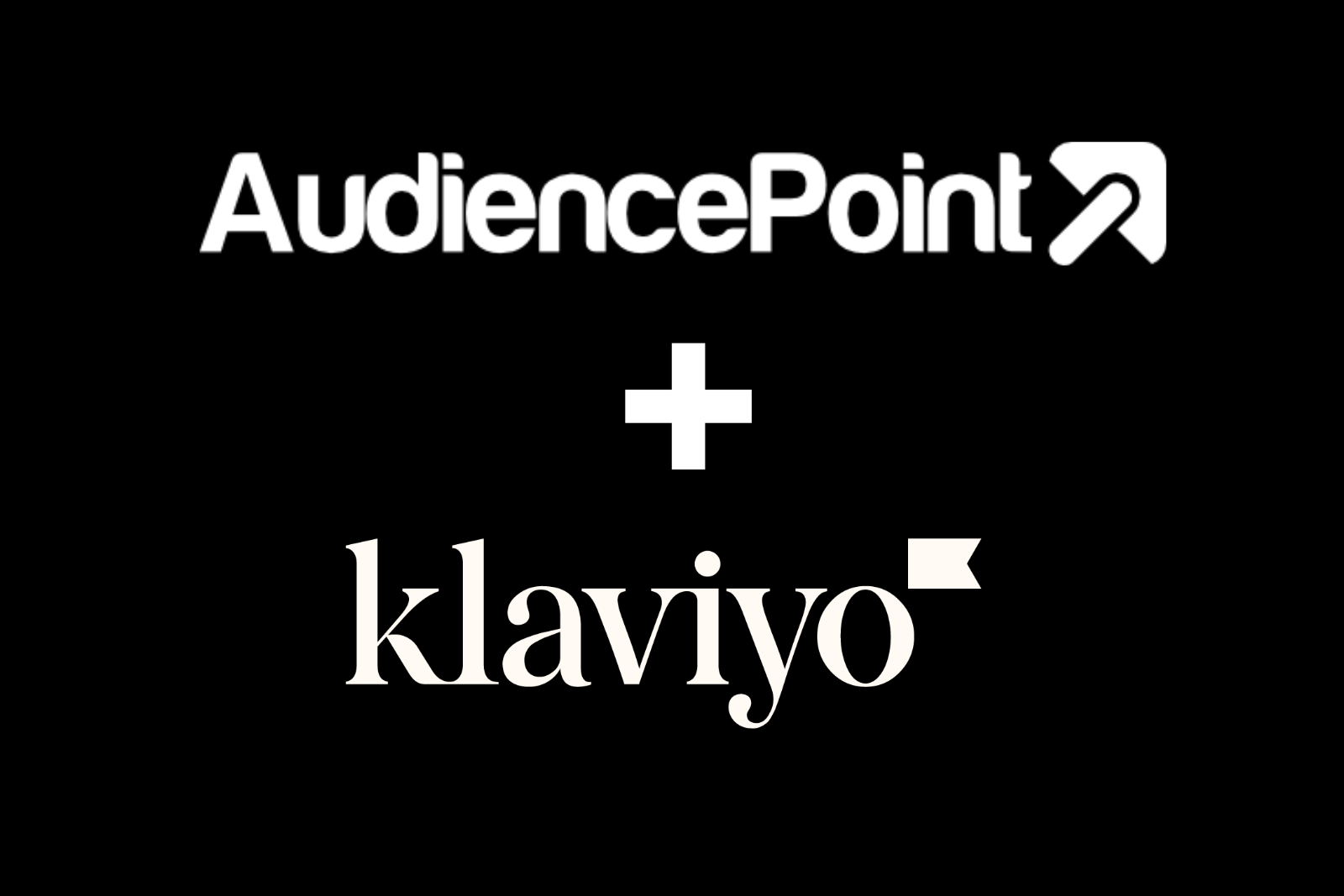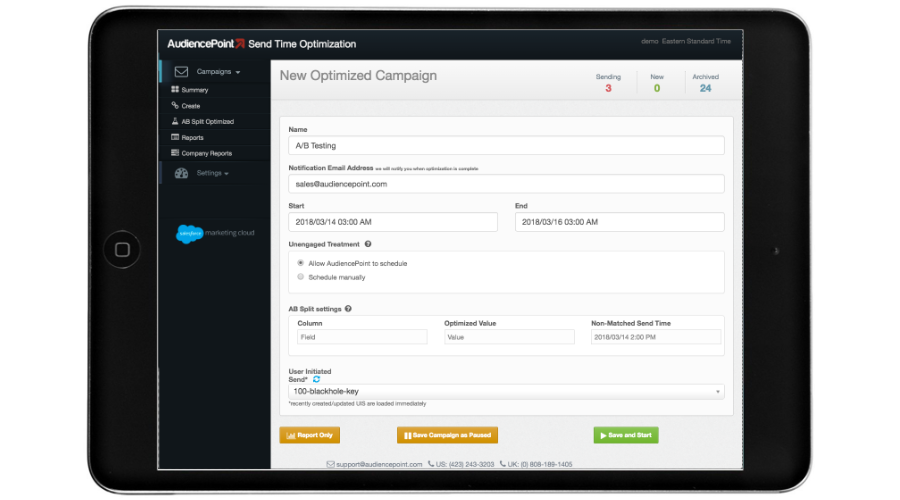AudiencePoint is thrilled to announce our new integration with Klaviyo! AudiencePoint is looking for partners to pilot our...
The 80/20 rule in email marketing applies the timeless Pareto Principle, advocating that 80% of your email content should focus on providing value through education, information, or entertainment, while the remaining 20% is reserved for direct promotion or sales. This ratio is designed to maximize subscriber engagement and retention by nurturing relationships rather than aggressively pushing products at every opportunity. By balancing informative content with carefully selected promotional messages, marketers position themselves as trusted resources in their subscribers’ inboxes—a prerequisite for long-term success in the digital landscape.
The Pareto principle originates from the observations of Italian economist Vilfredo Pareto, who noticed that 80% of Italy’s land was owned by 20% of the population. Today, the principle is widely used in business and marketing to illustrate that a small portion of efforts can drive most outcomes, for instance, understanding that 20% of your subscribers might be responsible for 80% of your engagement or revenue.
In the context of email marketing, the 80/20 rule translates into a content ratio: 80% of your emails should deliver pure value—think insightful tips, in-depth guides, industry news, and inspiration. The other 20% can be devoted to promotional content, such as new product launches, exclusive offers, or event announcements. Adhering to this balance is not just about following convention—it’s a strategic imperative. Recipients are bombarded with messages daily, and only those brands consistently delivering value will break through the noise and win subscriber loyalty. This value-driven approach enhances deliverability and inbox placement, as highly engaged subscribers are more likely to open, interact with, and whitelist your emails, key signals mailbox providers look for when determining where to place your messages.
Email marketing professionals should consistently audit their content calendar to ensure the 80/20 balance is maintained. Doing so prevents audience fatigue, boosts brand credibility, and consistently prompts positive engagement, each a pillar for campaign performance and reliable long-term revenue. Tools like AudiencePoint further empower marketers to monitor engagement metrics, fine-tune their strategies, and ensure their messaging always aligns with the 80/20 best practice for optimal results.
What Is The 80/20 Rule In Email Marketing: An Example
Understanding how the 80/20 rule (also known as the Pareto Principle) applies in real-world email marketing provides the blueprint for highly effective and engaging campaigns. The origins of the 80/20 rule trace back to the Italian economist Vilfredo Pareto, who observed that 80% of Italy’s land was owned by 20% of the population, highlighting a broader pattern of imbalance in wealth and resource distribution. This principle applies to various aspects of marketing and business, not just email marketing, and is especially useful for focusing on high-impact activities to maximize results, particularly when working with limited resources. In practice, this means structuring communications so that 80% of your email content delivers genuine value—such as actionable tips, insightful guides, or timely industry news—with only 20% dedicated to direct promotions like product offers or exclusive sales. This content mix not only keeps audiences engaged and looking forward to your emails, but it also helps build trust and long-term brand loyalty.
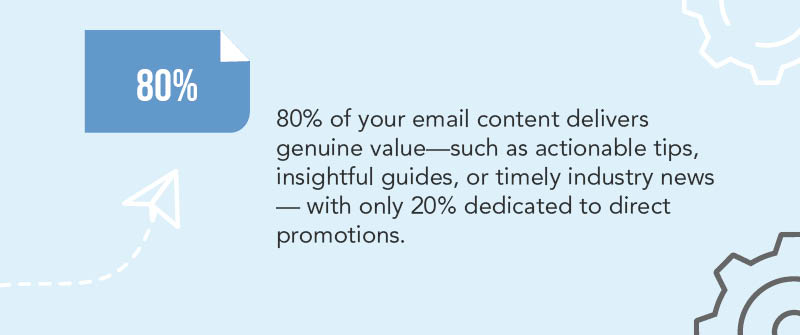
Let’s look at a sample email campaign crafted around this principle. Suppose you operate within the B2B SaaS sector: out of every five emails sent within a monthly cadence, four could focus on delivering case studies, productivity hacks, upcoming market trends, or spotlighting client success stories. This is your value-driven content. The fifth email might contain a limited-time offer for a free trial extension, a new premium feature announcement, or an invitation to an exclusive webinar—these are your promotions. In many cases, a small percentage of customers or efforts generate the majority of results, so focusing on high value customers and valuable customers is key. By implementing customer segmentation and identifying customer segments, you can target high value customers with loyalty programs and personalized content, fostering long term relationships and turning satisfied clients into brand advocates.
For value content (the 80%), it’s essential to consistently share impactful insights, best practices, or step-by-step guidance relevant to your subscribers’ pain points and aspirations. This positions your brand as an industry authority—a crucial component to maintaining high engagement and minimizing opt-outs. Track engagement rates, click through rates, and conversion rates to determine which content, blog post, or campaign generates the most engagement and significant results. Creating and implementing high impact activities, and leveraging data, helps maximize results—especially when resources are limited. On the flip side, your promotional content (the 20%) should feel like a value-add, not an intrusion. For example, rather than a generic sales pitch, an AudiencePoint client might send a personalized message offering a strategic audit, leveraging proprietary data to demonstrate tangible benefits. Use ads, optimized landing pages, and website improvements to increase sales and improve conversion rates for your services and products.
It’s important to set clear goals for each campaign and use feedback loops and informed decisions to optimize your content marketing strategies. Involve your entire team in focusing on top performers, brand advocates, and successful campaigns, and use customer interactions and core values to build trust. Not all content or blog posts will perform equally, so focusing on specific areas and marketing channels that deliver the most significant results is essential. For example, if you run an ecommerce store, creating targeted campaigns for different customer segments can help increase sales and foster long term relationships. The marketing landscape is always evolving, so continuously implement, create, and leverage new strategies to ensure ongoing success.
How AudiencePoint Recommends Implementing The 80/20 Balance
At AudiencePoint, we advise weaving the 80/20 rule into your content strategy by leveraging analytics to understand what value-driven content resonates with your unique audience. Use analytics to determine which content and marketing channels generate the most engagement and conversions. Our platform enhances this process by supplying actionable insights on subscriber engagement and email campaign success, helping you calibrate your content mix to maximize inbox placement and response rates. By establishing feedback loops and making informed decisions based on data, you can continuously optimize your strategy. With our robust analytics, you’ll quickly identify which informational topics excite your audience, which promotions yield true conversions, and who your top performers are. Additionally, customer segmentation allows you to tailor campaigns for different audience segments, making your campaign strategy both data-driven and dynamically adaptable.
Why Does This Content Mix Outperform?
The secret to outperforming with the 80/20 rule lies in delivering continuous value, nurturing a positive sender reputation, and reducing the risk of landing in the spam folder. By providing high-value content, you satisfy both the needs of your subscribers and the requirements of mailbox providers, improving your open and engagement metrics—a win-win that’s amplified when you adopt AudiencePoint’s advanced monitoring solutions.
To measure the effectiveness of the 80/20 content mix, track key metrics such as engagement rates, click through rates, and conversion rates across your campaigns. Focusing on high value customers not only increases revenue but can also turn them into brand advocates who promote your brand through positive word-of-mouth and recommendations.
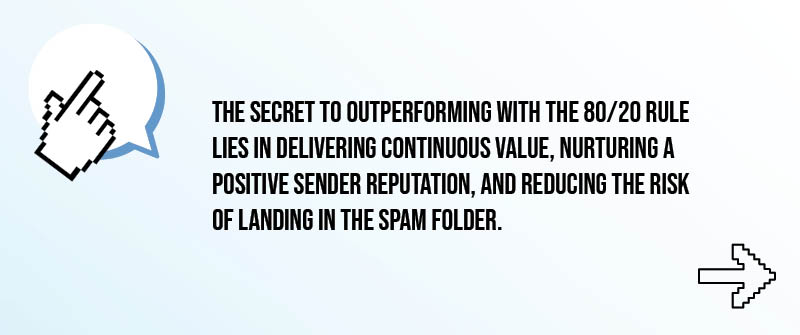
How Does The 80/20 Rule Compare To Other Marketing Rules?
Marketers frequently encounter a myriad of frameworks designed to maximize campaign performance, but not all rules are created equally or serve the same purpose. The 80/20 rule can be applied to specific areas of marketing, such as content creation, campaign management, and customer retention, by identifying and prioritizing high impact activities that drive the most significant results. Focusing on these high impact activities is crucial to maximize results, especially in a constantly evolving marketing landscape where adapting strategies to industry trends is essential. The 80/20 rule, 40/40/20 rule, and 30/30/30 rule each offer distinct approaches to constructing and optimizing marketing strategies. Understanding the differences among these rules is essential for email marketing professionals seeking superior engagement and ROI. Let’s break down how these rules compare and when each should be leveraged to achieve specific business and campaign objectives.
What Is The 40/40/20 Rule In Digital Marketing?
The 40/40/20 rule in digital marketing divides the ingredients of a campaign into three critical components: 40% audience targeting, 40% offer, and 20% creative execution. This means that 40% of your success hinges on reaching the right audience, another 40% on presenting an enticing offer, and the final 20% on how creatively you communicate that offer. Effective audience targeting relies on customer segmentation and identifying specific customer segments, enabling more precise and impactful marketing efforts. This rule highlights that even the most creative campaign will falter without the right message and audience alignment. In the context of email marketing strategy, applying the 40/40/20 rule ensures robust list segmentation and highly relevant offers, supported by compelling visuals, optimized ads, and landing pages to drive measurable action.
What Is The 30/30/30 Rule In Marketing?
The 30/30/30 rule, though less universally adopted than the previous two, often focuses on ensuring balance and consistency across three main elements relevant to a specific channel or goal. Depending on interpretation, these could be content, promotion, and follow-up, or share of effort, investment, and evaluation. In practice, the rule emphasizes a holistic approach—spreading marketing efforts and resources evenly to avoid over-committing in one single area. When operating with limited resources, it becomes even more important to prioritize efforts to maximize impact. Email professionals can use this rule to audit their campaigns, ensuring that neither content creation, offer development, nor performance analysis is neglected. To further enhance results, it is essential to implement feedback loops that gather input from both teams and customers, supporting continuous improvement and maintaining balance across all campaign elements.
Which Marketing Rule Is Most Effective For Email Campaigns?
AudiencePoint’s experience shows that effectiveness is about context. The 80/20 rule is unmatched for content planning—ensuring your subscribers receive genuine value 80% of the time and only 20% direct pitches. This approach increases engagement, strengthens sender reputation, and promotes deliverability. However, combining the insights of the 40/40/20 rule—especially in audience selection and offer optimization—further amplifies campaign results. The 30/30/30 rule is valuable as a periodic checkpoint for operational balance and resource allocation.
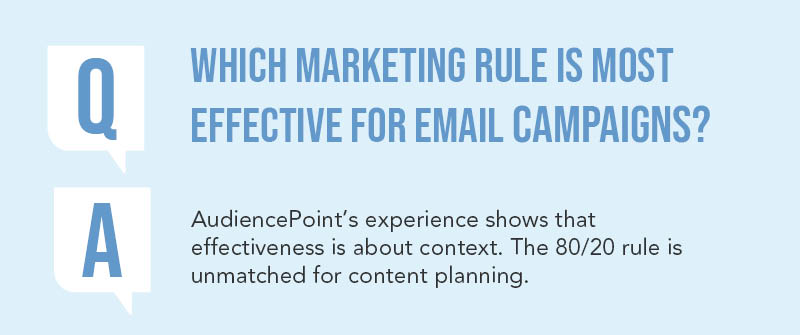
To ensure your campaigns are successful, it is essential to set clear goals and make informed decisions based on data and insights. Focusing on successful strategies and learning from top performers can help you replicate what works and drive better results.
Ultimately, high-performing email marketing strategies blend the best of these frameworks, with the 80/20 rule as your north star for content balance, and the 40/40/20 and 30/30/30 rules supplementing tactical execution. AudiencePoint gives you data-driven clarity to know when and how to apply these rules for maximum impact. Let our expert tools guide your strategy to unprecedented engagement and conversion.
Why Following The 80/20 Rule Leads To Better Email Marketing Results
Adhering to the 80/20 rule in email marketing isn’t just a matter of content balance—it’s a critical shift toward loyalty, trust, and optimal performance. Focusing on loyal customers and nurturing long term relationships through positive customer interactions helps build a strong foundation for your business. By prioritizing value-driven content, you maximize results and increase sales over time, while also directly impacting your deliverability and inbox placement, as mailbox providers increasingly factor engagement signals into spam-filtering algorithms. When you consistently offer informative and educational material that benefits your subscribers, they’re more inclined to open, click, and engage with your emails, sending positive signals to Internet Service Providers (ISPs) and ensuring your content lands in the inbox rather than the dreaded spam folder.
How Does Prioritizing Value-Driven Content Impact Deliverability And Inbox Placement?
Email marketing success hinges on more than just crafting valid messages; it’s about making meaningful contact. When your bulk of communications (80%) is educational, entertaining, or insightful, subscribers develop positive associations with your brand. Not only does this bolster open rates and click-throughs, but it improves deliverability because each engagement tells ISPs that your content is sought after. Tracking engagement rates, click through rates, and conversion rates is essential to measure the effectiveness of value-driven content and identify which campaigns perform best. In contrast, overloading your audience with promotions can lead to unsubscribes or, worse, spam complaints, which diminish sender reputation and bury future campaigns in spam.
What Role Does The 80/20 Rule Play In Building Long-Term Subscriber Relationships?
An 80/20 content approach demonstrates to subscribers that you respect their interests and time, rather than simply pushing products. This builds sustainable trust and goodwill, which is the foundation for lasting relationships and repeat business. Implementing loyalty programs can further nurture your most valuable customers, incentivizing repeat purchases and fostering deeper engagement. By investing in these high-value clients, you increase the likelihood that they will become brand advocates who promote your business through positive word-of-mouth and recommendations. Customers who trust your brand for valuable insights are more likely to remain loyal, refer others, and engage enthusiastically when you do present a timely, well-crafted promotion as part of the 20%.
How Can Advanced Analytics Tools Optimize Content Balance And Engagement?
While intuition and best practices shape content strategies, cutting-edge analytics platforms like AudiencePoint prove vital to ongoing optimization. Advanced subscriber insights from AudiencePoint enable marketers to identify precisely how audiences engage with each type of content. By monitoring real inbox signals—like opens, clicks, and placement—AudiencePoint empowers you to determine which content resonates most with your audience and make informed decisions based on data. The platform helps ensure that high value customers and top performers are identified, allowing you to focus efforts on these key segments for maximum impact. AudiencePoint enables you to tweak content balance dynamically, suppress disengaged recipients, and target your highest-value subscribers with tailored messaging. The platform bridges gaps left by older measurement approaches, giving you clarity around what is and isn’t working at a granular level.
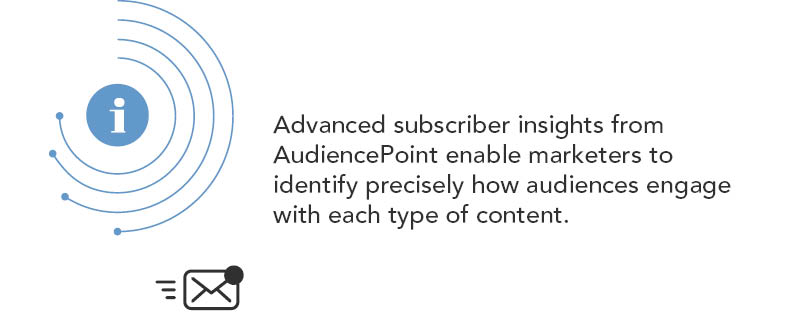
What Steps Can Marketers Take To Assess And Improve Their Value/Promotional Content Ratio?
Start by performing a content audit of your recent campaigns to categorize messaging as value-based or promotional. Use data-driven insights (such as those from AudiencePoint) to couple these content types with engagement metrics, inbox placement data, and list health indicators. Set clear goals for each campaign and establish feedback loops to gather input from both your team and your subscribers, ensuring continuous improvement. Focus on specific areas such as branding, social media, and email marketing, and prioritize marketing channels that deliver the best results for your business. If you find heavy promotional slant correlates with declining engagement or deliverability, pivot toward educational, industry-relevant content. Schedule regular reviews of your content mix, and A/B test different ratios to see what maximizes both subscriber satisfaction and business objectives.
Ready to unlock the full potential of the 80/20 rule and transform engagement? AudiencePoint delivers industry-leading data and actionable insights that let you master content balance, elevate inbox placement, and foster trustworthy, revenue-generating relationships with every campaign you send. Contact AudiencePoint and experience the smartest path to sustained email marketing growth with AudiencePoint’s superior analytics and real-time subscriber intelligence.

